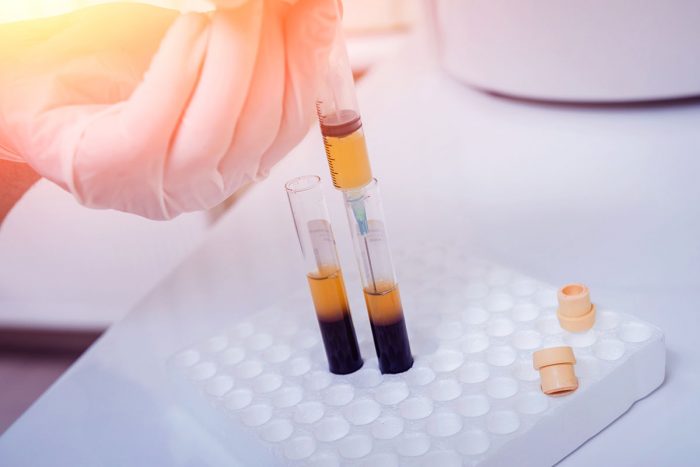Possible COVID-19 treatment: transfusion of antibodies from recovered patients’ blood
Century-old idea applied to modern pandemic
 Getty Images
Getty ImagesA laboratory worker removes plasma from a vial of blood. Researchers at Washington University School of Medicine in St. Louis and elsewhere are investigating whether transfusions of blood plasma from people who have recovered from COVID-19 can prevent or treat the disease. The approach was used with some success during the 1918 influenza pandemic.
Editor’s Note: On March 24, the FDA announced it had approved the investigational use of blood plasma from recovered patients as a treatment for COVID-19. The FDA also announced it would facilitate access to the experimental treatment for critically ill patients while clinical trials are underway. The decision opens up the possibility that hospitals across the country soon could be using plasma transfusions to treat their sickest COVID-19 patients.
With no drugs or vaccines yet approved for COVID-19 and the number of U.S. cases increasing by the thousands every day, doctors are looking to revive a century-old therapy for infectious diseases: transfusing antibodies from the blood of recovered patients into people who are seriously ill.
During the Spanish flu pandemic of 1918, doctors were faced with a deadly illness and no specific treatments. Recognizing that people who had recovered were immune to the infection, some doctors tried treating their patients with blood serum from recovered flu patients. In many cases it worked.
“Giving serum from newly recovered patients is a stone-age approach, but historically it has worked,” said Jeffrey P. Henderson, MD, PhD, an associate professor of medicine and of molecular microbiology at Washington University School of Medicine in St. Louis. “This is how we used to prevent and treat viral infections like measles, mumps, polio and influenza, but once vaccines were developed, the technique understandably fell out of favor and many people forgot about it. Until we have specific drugs and vaccines for COVID-19, this approach could save lives.”
Henderson was reminded of the technique by Arturo Casadevall, MD, PhD, the chair of molecular microbiology and immunology at Johns Hopkins Bloomberg School of Public Health in Baltimore. Casadevall began championing the idea of using plasma from convalescing patients to treat COVID-19 in early March. Plasma and serum are both the clear fluid portion of blood, and both contain antibodies, but plasma also contains some other proteins lacking in serum.
Plasma transfusion was used experimentally to treat small numbers of people during the SARS outbreak of 2002 and 2003. SARS, which stands for severe acute respiratory syndrome, is caused by a coronavirus closely related to the one that causes COVID-19. In one study, SARS patients who received plasma transfusions recovered faster than those who did not.
Henderson, Casadevall and Michael Joyner, MD, a physiologist at the Mayo Clinic in Rochester, Minn., quickly joined forces and leveraged the resources at their three institutions to test the approach. Their efforts resulted in an investigational new drug application to the Food and Drug Administration that was filed March 18. If the application is approved, they plan to move rapidly to a clinical trial.
“This is something that can be done very quickly, much faster than drug development, because it basically involves donating and transfusing plasma,” Henderson said. “As soon as we have individuals who have recovered from COVID-19 walking around, we have potential donors, and we can use the blood bank system to obtain plasma and distribute it to the patients who need it.”
The plan is to ask patients who recover from COVID-19 to donate their blood, from which plasma would be isolated. After screening for toxins and viruses, the plasma would be transfused into people ill with or at high risk of COVID-19. The procedure for isolating plasma is a long-established technology that can be performed using equipment normally found in blood-banking facilities, and receiving plasma from these donors is as safe as any other plasma transfusion, Henderson said.
The concept is simple, but the execution is more complicated. The scientists still need to determine how much antibody is in the blood of recovered patients, and how much antibody needs to be given to effectively treat or prevent COVID-19. Brenda Grossman, MD, a professor of pathology and immunology at Washington University School of Medicine and director of transfusion medicine at Barnes-Jewish Hospital, was brought on board to help navigate the complex regulations surrounding blood donations and transport of blood products across state lines.
The idea is catching fire.
“Last week, it was the three of us on a conference call,” Henderson said. “This week, we had people from all over the country – I don’t even know how many. Everyone’s excited about this. If it works, it could provide a lifeline at this early stage of the pandemic.”
 Related: School of Medicine physicians, researchers tackle coronavirus
Related: School of Medicine physicians, researchers tackle coronavirus
Clinical teams ready; research for vaccines, drugs underway






